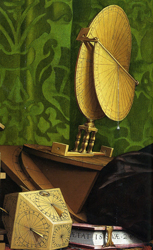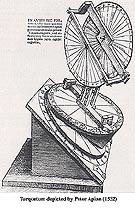


Foister includes the following valuable discussion:
This is a torquetum, an instrument first described by the ancient Greek scientist Ptolemy, which could be used to determine the relative positions of the heavenly bodies and tell the time with some accuracy. Its complex construction allowed it to be adjusted for latitude and date; altitudes were measured against a plumbline on the pendant semicircular flap. Knowledge of this instrument was revived in the thirteenth century, and in the fifteenth and sixteenth centuries there was much interest in designing versions of it, only a very few of which survive. One such instrument was designed by Peter Apian of Nuremberg, one of the leading instrument makers in the early sixteenth century, and published in his Astronomicum Caesareum in 1540

For a modern reconstruction and discussion see the entry for Torquetum in Richard A. Paselk's Medieval Science and Scientific Instruments site.
